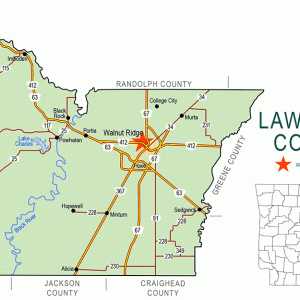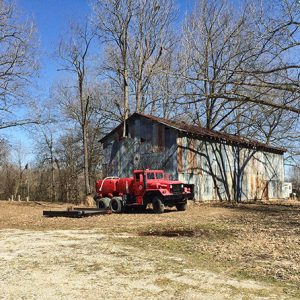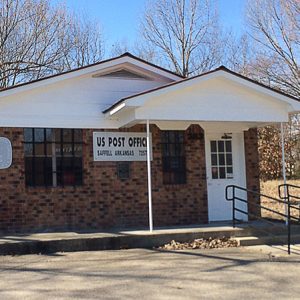calsfoundation@cals.org
Saffell (Lawrence County)
Saffell is an unincorporated community in Reeds Creek Township located at the junction of Arkansas Highway 25 and Arkansas Highway 361 about three and a half miles south-southeast of Strawberry (Lawrence County). Saffell lies approximately four miles northwest of the confluence of the Strawberry and Black rivers. Farming is important to the livelihood of the community. In 2015, the population of the Saffell area was estimated at 190.
Osage Indians once claimed the Strawberry and Black river bottoms, along with most of northern Arkansas, as their hunting grounds. Burial mounds are located across the Strawberry River from Saffell on the old White Plantation. French hunters, trappers, and fur traders, mostly from Canada, plied the Strawberry and Black rivers in the eighteenth century and continued after the Louisiana Purchase of 1803. In about 1815, they deeded their claims to land speculators for remuneration. A few settled in the area and have descendants living there in the twenty-first century.
During the early history of Saffell, the area was most often referred to as Reeds Creek. The Jackson Military Road of 1831, which paralleled the old Southwest Trail, ran through Lynn (Lawrence County), six and a half miles north-northeast of Saffell, and then through Hazel Grove and Walnut Grove in Independence County. It crossed the White River through the Rosie Valley, Pleasant Plains (Independence County), Little Rock (Pulaski County), and beyond. The key towns of Batesville (Independence County) and Smithville (Lawrence County) were bypassed by the road, as was what would become Saffell.
One of the early settlers of Saffell was John E. Willmuth, who arrived in Strawberry with his family from Graves County, Kentucky, at the age of two in 1842. In the midst of the Civil War, he married Lucinda Campbell of Reeds Creek and owned several acres of farmland. Both are buried in the Mount Zion Cemetery in Saffell. John Willmuth was an elder of the church, which no longer stands.
At age seventeen, John Anderson Saffell moved with his family from Tennessee to Reeds Creek in Lawrence County in 1858. At the start of the Civil War, he became a Confederate soldier, a private in Company H, Clark’s Forty-fifth Arkansas Cavalry. Shortly after being discharged, he married Mary “Polly” Taylor of Lawrence County and became a successful merchant in the Strawberry area. They are buried in the Saffell Cemetery.
A post office was established at Saffell on July 13, 1901, with William F. Penn appointed postmaster. John Anderson Saffell was appointed postmaster in 1903. He had a general store, first located in Strawberry, that sold dry goods, groceries, boots and shoes, and hardware. Dr. D. Jayne’s family medicines were advertised as being for sale at his store. The post office was part of the store, hence the name Saffell for the post office and community. The post office was closed in 1905, but a new post office was opened in 1912 and is still active in the twenty-first century. The present post office is located on Highway 25 in Saffell.
In the early 1900s, John Anderson Saffell’s grandson, Hollie Saffell, and his wife, Hattie Willmuth Saffell, owned and operated a cotton gin by the Saffell Cemetery. The building is still standing, as are the old store buildings. The Saffell school was called Harmony and served grades 1–8. It merged with the Strawberry school in the 1940s. The Hillcrest School District was created in 2004; it included Strawberry and served remote parts of Lawrence, Sharp, and Independence counties. The elementary school is in Lynn, and the high school is in Strawberry.
Collecting freshwater pearls and mussels for the button factories proved to be a lucrative business along the Strawberry, Black, and White rivers from the late 1800s until the 1950s and 1960s. Freshwater pearls collected from the rivers had been used by Native Americans before the arrival of the Europeans, but it was not until 1897 when pearls were discovered by settlers on the Black River in Black Rock (Lawrence County) that the business mushroomed almost overnight and button factories sprang up along the rivers. World War II restrictions on zippers and other metal garment closures for the war effort proved a stimulus for the economically depressed button manufacturers, but the industry slumped following the war, and foreign competition, especially from the Japanese, led to the decline of the button industry on the rivers near Saffell.
Although Saffell has been overshadowed by the nearby community of Strawberry, it is still a vibrant farm community on the main road between Cord (Independence County) and Strawberry.
For additional information:
Craig, Robert D. “Pearling, the Arkansas Klondike.” Stream of History 47 (August 2014): 3–16.
McLeod, Walter. “Early Lawrence County History.” Arkansas Historical Quarterly 3 (Spring 1944): 37–52.
Poudel, Sujata. “Species Richness, Distribution and Relative Abundance of Freshwater Mussels (Unionidae) of the Strawberry River, Arkansas.” MS thesis, University of Massachusetts, Boston, 2012.
Stewart, Glynda. “Black Rock Pearling and Button-Cutting Industry.” Lawrence County Historical Quarterly 1, no. 4 (1978): 5–9.
Stroud, Larry. “The Old Military Roads.” Batesville Guard, April 12, 2012.
Kenneth Rorie
Van Buren, Arkansas
 Lawrence County Map
Lawrence County Map  Saffell Gin
Saffell Gin  Saffell Post Office
Saffell Post Office 




Thank you for your contribution. It’s really interesting to know about Saffell, Arkansas, and the rich history surrounding that place.